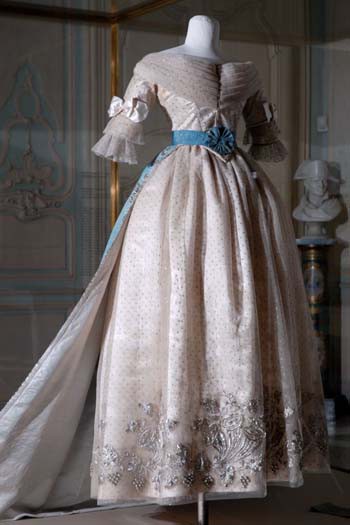This ball gown and matching train which once belonged to Marie-Louise is without doubt one of the most remarkable pieces owned by the Museo Glauco Lombardi.
Lombardi, a collector of Napoleonic and resident of the Italian city of Parma, bought the gala outfit from Giovanni Sanvitale in 1934, himself a descendant of Marie-Louise; Giovanni was the grandson of Luigi Sanvitale and Albertina Montenuovo, daughter of Marie-Louise and the one-eyed general Adam Neipperg, Marie-Louise's second husband. For the princely sum of 105,000 lira, Lombardi acquired a vast collection of objects, works of art and memorabilia related to Marie-Louise, but only on the proviso that he create a museum open to the public.
The sumptuous ball costume was used by the duchess at formal occasions. It would appear to have been bought in Paris in 1838, since the purchase of a sky-blue cape and a white tulle train in Paris at that time is mentioned in an inventory of Marie-Louis's ball gowns dated 1840. It therefore an outfit she used at the end of her life; she was to die seven years later.
The ball costume comprises three sections: a bodice cut in silk and tulle, a skirt with tight pleats (again made of silk and embroidered tulle), and a train made of “gros de Tours” moiré (heavy silk moiré) and fastened at the waist. There is embroidery all over the dress (there are silk thread mouches everywhere) but this decoration is concentrated on the lower part of the skirt and around the edge of the cape. The motifs include cornucopias, vines and bunches of grapes, symbols of abundance and prosperity, alluding to the sovereign's happy rule.
A light blue sash bear the decoration of the Grand Cross of the Constantinian Order of St George, of which Marie-Louise was the Grand Master.
Francesca Sandrini (tr. P.H.)
Director of the Museo Glauco Lombardi, Parma
January 2008
Marie-Louise’s Ball Gown and Train

- Date :
- 1835-1840
- Technique :
- silk, tulle, silver copper lamé
- Dimensions :
- H = 120 cm, L = 270 cm, Diam. = 64 cm
- Place held :
- Museo Glauco Lombardi, Parma, Italy
- Photo credit :
- Museo Glauco Lombardi, Parma, Italy

